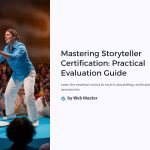
 In today’s dynamic world, storytelling has emerged as a pivotal skill across various domains, from education to marketing. For those aspiring to certify their storytelling prowess, understanding the practical evaluation criteria is essential. This guide delves into the core aspects that evaluators focus on during storytelling proficiency assessments.
In today’s dynamic world, storytelling has emerged as a pivotal skill across various domains, from education to marketing. For those aspiring to certify their storytelling prowess, understanding the practical evaluation criteria is essential. This guide delves into the core aspects that evaluators focus on during storytelling proficiency assessments.

Comprehending the Essence of Storytelling Certifications
Storytelling certifications are designed to validate an individual’s ability to craft and deliver compelling narratives. These certifications assess not just the flair for storytelling but also the structured approach and effectiveness in engaging the audience. Recognizing the components of these certifications provides a roadmap for preparation.

Key Evaluation Criteria in Storytelling Proficiency Tests
Evaluators typically focus on several critical aspects during storytelling assessments:
- Narrative Structure: A well-structured story with a clear beginning, development, climax, and conclusion is fundamental. The coherence and logical flow of the narrative are scrutinized.
- Character Development: The depth and relatability of characters enhance the story’s impact. Evaluators look for characters that resonate with the audience.
- Engagement Techniques: Utilizing hooks, suspense, and emotional appeals to captivate the audience is crucial. The storyteller’s ability to maintain interest throughout the narrative is assessed.
- Delivery and Presentation: Voice modulation, body language, and eye contact play significant roles in effective storytelling. Confidence and authenticity in delivery are key metrics.
- Creativity and Originality: Innovative plots and unique perspectives set a storyteller apart. Originality in content and approach is highly valued.

Practical Components of the Assessment
Storytelling proficiency tests often comprise both theoretical and practical components:
- Theoretical Knowledge: Understanding storytelling theories, narrative techniques, and audience psychology forms the foundation.
- Practical Demonstration: Candidates may be required to perform live storytelling sessions, showcasing their ability to apply theoretical knowledge in real-time scenarios.

Preparing for the Practical Evaluation
To excel in the practical aspects of storytelling assessments:
- Practice Regularly: Engage in frequent storytelling sessions to refine delivery and adapt to diverse audiences.
- Seek Feedback: Constructive criticism from peers and mentors can highlight areas for improvement.
- Study Exemplary Storytellers: Analyzing the techniques of renowned storytellers provides insights into effective storytelling methods.
Resources for Aspiring Storytellers
Enhance your storytelling skills with these resources:
MasterClass: Storytelling Techniques
Coursera: Storytelling Courses
6imz_ Conclusion: Embarking on Your Storytelling Journey
Mastering the practical evaluation criteria for storytelling requires a blend of creativity, structured planning, and continuous practice. By focusing on the key aspects highlighted above and utilizing available resources, aspiring storytellers can enhance their skills and succeed in proficiency assessments.
*Capturing unauthorized images is prohibited*






